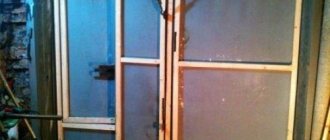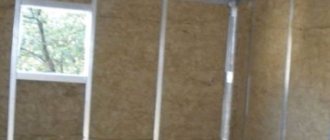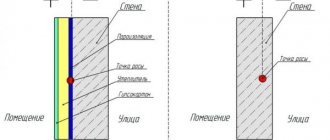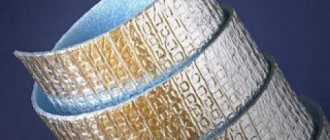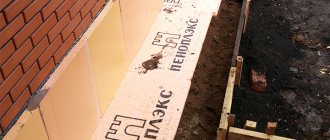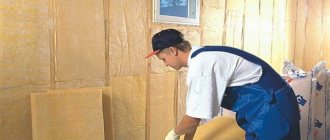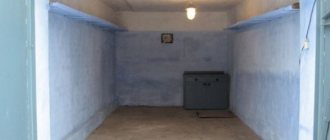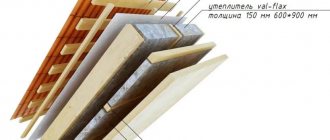External garage roof insulation technology
Since the room itself is not always heated, it is extremely important that the material itself retains its insulating abilities at any room temperature.
An equally important point concerns machine exhausts and vapors from fuels and lubricants, which accumulate on roofing insulation over time and can reduce the degree of their fire resistance. That is why it is worth choosing mineral wool or fiberglass as insulation.
If the installation of the insulating layer will be carried out in the garage with your own hands, it is worth considering the option of foam insulation or polystyrene foam, which are easy to use. These same materials are resistant to possible deformation and retain their original elasticity throughout their entire service life.
Nuances of choice
What should you pay attention to when planning to insulate your garage roof? Firstly, the garage must have a working ventilation hole for exhaust gases. In addition, without an influx of fresh air, it is impossible to get rid of excess humidity in the room.
Secondly, in a garage there is a risk of fire, so you should not insulate the room with flammable materials - in the event of a fire, the fire will spread quickly.
Thirdly, it is better to choose insulation materials that do not react to moisture. You can, of course, arrange insulation with film or foil. However, over time, moisture will still gradually begin to penetrate into the fibrous insulation and deteriorate its quality.
Internal location of insulation
When figuring out how to insulate a flat roof from the outside, do not forget that insulation can also be done from the inside. This solution is especially relevant if there is an unused or technical attic space. In this option, all the necessary materials are attached to the ceiling from the inside. However, this does not relieve the need for external waterproofing.
This method of insulation is less effective than external insulation, but in some cases it may be the only possible one. Here, all the components of the structure and their arrangement will correspond to classic external insulation, with the only difference being that they will be located not from bottom to top, but from top to bottom, in the reverse order.
The only difference is the creation of a heat-insulating structure in residential premises, when the outer side of the assembled pie will act as a ceiling. In this case, the external component of the assembled “pie” will be a decorative coating. This can be either a suspended ceiling or any other solution that is more suitable in appearance or suits the taste of the owner of the house.
Steam protection of attic floors
The function of the vapor barrier film in a thermal insulation cake is to prevent water suspended in the air from penetrating into building structures. This means that it is the vapor barrier that must stop the evaporation in order to either not let through at all or reduce to minimum values what managed to pass through it.
We have already found out that in our regions, steam, along with the air flow, most often moves from buildings to the outside. Only in the summer heat is reverse current possible.
The vapor barrier layer should be the first in the path of moist air. Consequently, it is laid on the side of the used premises before thermal insulation.
The installation of a vapor barrier along the ceiling is carried out if the attic is not intended to be heated. In this case, there is no point in insulating the attic space at all, because... it will not be used at all or will be used as a cold warehouse.
True, it is still necessary to protect the materials of the sheathing of the slopes and rafter frame. Waterproofing is installed against external influences, and a ventilation system is installed against the formation of condensation occurring due to the difference in temperatures inside and outside the structure.
According to the requirements of building regulations, in winter the temperature inside a cold attic should not exceed that outside by more than 5 - 6º C.
The rules outlined in SP 17.13330.2011 state that in order to equalize the temperature and humidity parameters inside and outside the attic, it is necessary to arrange a natural type of ventilation.
This means that it is necessary to provide the roof structure with vents, dormer windows, aerators, etc. The total area of ventilation openings, regardless of their type and purpose, should be on average 1/300 of the floor area or horizontal projection of the roof. The described measure is quite sufficient to maintain the temperature and humidity balance specified by building regulations.
Thermal insulation of a flat roof, which materials to choose
Recommendations for choosing material are the same as for any other design. For these purposes, basalt wool or extruded polystyrene foam is used. Let's look at their features
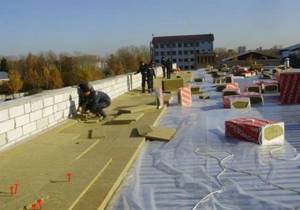
Insulation of a flat roof with mineral wool:
- Environmentally friendly product
- Permits steam and allows the roof to breathe
- Good thermal insulation
- High density, can be laid to suit the surface being used
- Fire safety, does not burn, does not melt, does not emit harmful substances
- Heavy weight, you must initially calculate the load
- Hygroscopicity, if the waterproofing is damaged, it will absorb moisture and lose its properties
- High price
Insulation of a flat roof with polystyrene foam
- Light weight, easy to install, transport, does not increase the load on the foundation
- Low price
- Not susceptible to moisture
- Good thermal insulation
- This is artificial material
- Burns or melts, in most cases does not meet fire safety requirements
- Does not allow steam to pass through
More often, basalt wool slabs are still used to insulate a flat roof. Since this is a more reliable and durable method. Also, this allows you not only to insulate rooms from the cold, but also saves you from heat in the summer, which cannot be said about other materials. And thanks to vapor permeability and the fact that the slabs are made from natural raw materials, a favorable microclimate is created indoors.
Types of thermal insulation materials
Fiberglass insulation is sold in rolls or in sheet form. The insulating properties are the same as those of ordinary glass. It does not burn, will not rot from moisture, and will not collapse under the influence of an aggressive environment. The structure of the smallest fibers ensures low thermal conductivity of the material.
Fiberglass is a fragile material, so it should not be subjected to mechanical stress, otherwise the fibers will be damaged. When using this material, you must ensure that the smallest particles do not come into contact with the skin, especially the eyes or respiratory system: this can cause serious harm to health. If this happens, consult your doctor immediately. When purchasing material, make sure that the packaging is not damaged: the insulation may spill or become wet, and wet fiber will not insulate properly in a cold room.
In some cases, insulating a garage roof is not much different from insulating a regular house roof.
Mineral fiber has a similar structure, but is made from a different material - basalt rocks. Basalt melts and forms thin fibers. This material is more ductile and flexible than fiberglass. Therefore, it is less susceptible to mechanical damage. Mineral wool has low thermal conductivity and is used as a soundproofing material. When installed correctly and protected from moisture, mineral wool insulation will last a long time.
Another method is polymer insulation. It is performed using material obtained by extrusion of polymers. The porous structure of the polymer has heat-insulating properties. The material is produced in slabs of various sizes and thicknesses. Insulating the roof from the inside with polymer is very popular. Advantages include reasonable cost, low thermal conductivity, and ease of installation. Polymer insulation is very light. The design does not suffer from excess load.
Polymer materials do not absorb moisture, unlike fibrous materials. However, we should not forget about the disadvantages.
Insulation layers must be properly protected from sunlight. If a fire occurs in the garage, this insulation will burn very quickly.
Now new types of insulation are emerging, some of which have added substances to prevent the spread of flame.
Natural insulation materials are not often used in garages. These include felt, wool, cotton and paper insulation. Material of this class is treated with a special impregnation that prevents them from burning. Insulation made from natural materials is quite durable and can last a long time.
External and internal roof insulation
To keep the heat in the room, you will need to install 3 layers of thermal insulation structure:
- waterproofing;
- insulating material;
- vapor barrier.
When planning to insulate your garage roof from the inside, you need to pay attention to the following factors. The garage must have working ventilation - then exhaust gases will be removed from the room in a timely manner, otherwise serious poisoning can occur. In addition, without fresh air it is difficult to get rid of excess moisture. And then, over time, the car body will begin to rust.
External insulation of the garage roof can be performed during its construction. To do this, you need to install one layer of vapor barrier. It is important that moisture does not penetrate into the insulation: evaporation must go outside. If steam collects and condenses on the ceiling and insulation material, its service life may be significantly reduced. Next, you need to secure a layer of thermal insulation materials; you can take a piece of foam plastic for this.
The process of installing foam boards on the ceiling is very simple.
This material is secured with special plastic dowels. The edges of the plates should be additionally glued for reliability. The remaining cracks should be sealed with foam. Instead of expanded polystyrene boards, mineral wool is also suitable. But to install this insulation you will have to build a wooden frame. The last element of the thermal insulation pie is waterproofing. The joints and edges of the film must be sealed with tape, after which roofing materials can be laid.
If there are beams on the inside of the garage ceiling, a different insulation scheme should be chosen. In the first stage, the beams are covered with sheet material, and then insulation made of fibrous insulating material is attached to the bottom.
To fix the mineral wool insulation, you will need to create a structure from wooden beams, insert layers of fiber insulation between them. We cover the entire structure with foil or film to prevent moisture from getting on the insulation. Using liquid penoizol, the work is much simpler: it is simply sprayed over the surface. Thus, it penetrates into cracks and hard-to-reach places. The material hardens quickly, forming an even layer that prevents the penetration of cold air.
After completing the work of insulating the garage roof from the inside and outside, pay attention to the walls and gates. These elements are also easy to insulate yourself - if you wish.
Two roofing pie recipes
The main difference between the two methods is the space occupied by the waterproofing material. In a classic roof, it crowns the entire structure, and in an inversion roof it is placed under the insulation, acting as protection for the floor slab, and not for the heat-saving layer. That is why mineral wool is not the most suitable place here - the fiber board will have to be carefully protected from atmospheric moisture.
Classic roofing (order from bottom to top):
- Vapor barrier from inside the room, if necessary.
- Concrete floor slab (it is possible to install a roof on top of rafters laid parallel to the base)
- Slope-forming cement screed or PENOPLEX layer mounted at an angle of 2-4% on stops (cut from the same material) or PENOPLEX SLOPE
- Insulation in one or more layers (in a checkerboard pattern). The manufacturer recommends laying a special separating material under and on top of the slabs.
- Waterproofing is most often a durable polymer roofing material. For the option of laying directly on PENOPLEX, a roofing membrane, for example, Plastfoil, is excellent.
This “pie” option is interesting if you are not going to use the flat roof space. The classic roof is just a roof. It is much more profitable to complicate the installation stage a little, but in the end get a durable and functional space. To do this you need an inversion roof (order from bottom to top):
- Concrete floor slab or rafters
- Slope-forming cement screed or PENOPLEX SLOPE
- Waterproofing membrane.
- Geotextile layer.
- Insulation in one or two layers (in a checkerboard pattern).
- Anti-root layer made of geotextile.
- A ballast layer of gravel - it “presses” the layers against each other, preventing them from moving. In the case of a green zone, it also performs a drainage function.
- (Optional) filtration layer.
- (Optional) soil layer.
Here is a version of the very popular “green” roofing all over the world. But the soil layer can be replaced with ceramic tiles or decking boards.
In this case, the heat-saving material also serves as a load-bearing material; it bears the main load from the equipment that will be placed on the roof, from the weight and active movement of people, the impact when some objects fall on the surface and, of course, the atmospheric load. PENOPLEX is perhaps the only available material that is capable of this.
How to insulate a concrete roof with your own hands
To prevent condensation, it is necessary to protect cold concrete structures from warm air, which contains a lot of moisture. When the air cools, moisture vapor precipitates in the form of condensation. Insulation of reinforced concrete slabs can be done inside and outside, but the stages of work, types of thermal insulation and finishing materials will differ. Let's look at insulating a flat concrete roof step by step.
How to insulate a concrete roof from the outside
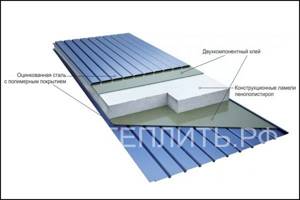
The structure of a sandwich panel with polystyrene foam insulation
The simplest and most reliable way to insulate a flat roof from the outside is to use sandwich panels. As can be seen from the photo, such a panel consists of two sheets of galvanized or painted corrugated board, between which there is polystyrene foam. On the one hand, sandwich panels are reliably protected from moisture and mechanical damage and can withstand heavy loads, and on the other hand they have low thermal conductivity.
Laying sandwich panels will require the use of construction equipment, which will significantly increase the cost of the work. A simpler option, when you can insulate a concrete roof yourself, is to use expanded polystyrene with roll waterproofing, for example, roofing felt. This technology is shown in the video at the end of the material. Such insulation of slabs can last for many years, the main thing is to check the waterproofing.
How to insulate a concrete roof from the inside
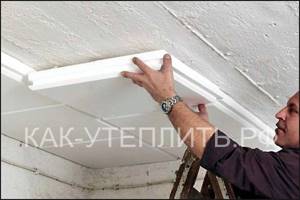
Photo. How to insulate a concrete ceiling and ceilings with foam plastic
It will be much easier and cheaper to insulate this structure from below, provided that you do not have to dismantle the expensive finishing on the ceiling. The easiest and most inexpensive way to insulate any surface is to use foam boards, despite the fact that it is a highly flammable material. If you plan to sheathe the ceiling in the future, this will not be a serious problem, especially if you use plasterboard sheets for finishing.
You can use non-flammable basalt thermal insulation, but attaching it to the ceiling will be much more difficult. It will be necessary to make an additional frame from profiles, as well as protect the mineral wool with a vapor barrier. In the video at the end of the article, we have selected a video clip for you, where one of the craftsmen shares his method of insulating a concrete garage roof from the street, using polystyrene foam boards, plywood sheets and roofing felt for thermal insulation.
Requirements for insulation material
A garage is a specific room; the usual methods of insulation that would suit a residential building or a summer kitchen are inappropriate here. It is known that the worst enemy of a car is corrosion. And it occurs due to condensation, which, in turn, appears due to the temperature difference between indoors and outdoors.
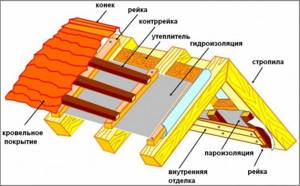
There is only one way to deal with condensation - drying the wet drops with warm air. If it is not possible to heat the garage, it needs to be properly insulated. Material for these purposes must:
- be non-flammable, because with the slightest spark you can lose not only the garage itself, but also the car stored in it;
- do not absorb vapors of auto chemicals, oils and gasoline, so as not to become a source of toxins and volatile poisons over time;
- have a non-porous structure so as not to accumulate moisture;
- have a small mass so as not to weigh down the garage roof and the entire structure;
- have a long service life;
- do not attract rodents and insects;
- not exposed to fungus and mold.
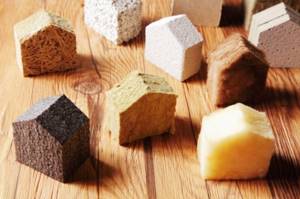
Outdoor installation
With this approach, all layers of insulation and waterproofing are located on the outside of the ceiling. Accordingly, it is necessary to create a heat-saving “pie” that can withstand all temperature and climate changes. There are two main types of flat roofs, insulated differently:
A classic roof is insulated according to a standard scheme and the layers are laid in the following order, counting from bottom to top:
- Floor slab
- Vapor barrier film
- Insulation
- Waterproofing

This scheme has a significant drawback - external waterproofing requires periodic maintenance and repair. It is produced every two to three years and this entails additional costs, although such a roofing device is slightly cheaper than the other option - the inversion one.
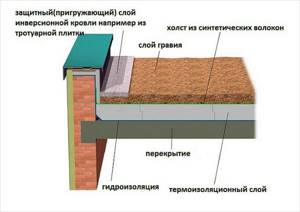
This type of roofing is considered more expensive to install, but it withstands temperature changes better and does not require such frequent repairs. Its fundamental difference from the classic version will be a different scheme for laying layers and arrangement:
- The first will be, as in the previous case, the floor slab
- Then - screed
- Next comes waterproofing
- Next is insulation
- A special film is placed on top - a filter.
- Cover the pie with expanded clay or gravel, at least 50 millimeters thick
This solution allows you to protect the waterproofing gasket and significantly increase its service life.
Wooden floor construction
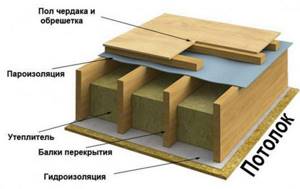
The structure of the wooden floor has the following structure (layers are arranged from top to bottom):
- the floor of the upper floor or attic (can be rough or finished depending on the purpose of the room);
- vapor barrier layer;
- load-bearing beam structures;
- thermal insulation material is placed between the beams and protects against cold and impact noise;
- waterproofing layer;
- wooden ceiling in the bathroom or finishing made of another material.
It is especially important to treat all wooden structures with antiseptics and fire retardants to protect against rot and mold, as well as reduce the flammability of the material. For thermal insulation of the ceiling, mineral or basalt wool, polystyrene foam boards or polystyrene foam are used.
Steam and waterproofing materials
To answer the question of which vapor barrier is best for the ceiling of a wooden house, you need to consider all the varieties.
The following types of vapor barrier exist:
- foil insulators;
- polypropylene film materials;
- polyethylene films with reinforcement and perforation;
- multilayer membrane insulation;
- coating insulators (used only for treating brick and concrete surfaces).
If you are interested in an inexpensive and effective vapor barrier for a wooden ceiling, the price of films made of polyethylene and polypropylene starts from $0.5 (32 rubles) per linear meter. More durable and durable films have a reinforcing layer of mesh or fabric. These materials are resistant to ultraviolet radiation.
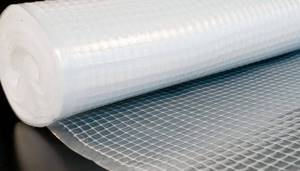
In addition, reinforced film materials are single-layer and multi-layer with a foil layer. The latest type of film is the best because it additionally protects the room from heat loss by reflecting heat into the room. Polypropylene films allow water vapor to pass out and absorb moisture.
Foil insulation is a multilayer material that protects against steam penetration, additionally insulates the room and increases its thermal insulation.
There are the following types of rolled foil vapor barrier:
- Materials with foil coating on one side, having a fiberglass mesh base. They are used in rooms with temperature changes and high humidity.
- Three-layer insulation based on fiberglass mesh has a foil coating on both sides. This insulation material is suitable for installation in timber floors and for use in attics.
- Self-adhesive film with foil on one side is suitable for installation on uneven substrates.
- Three-layer insulator based on kraft paper, impregnated with molten polyethylene and coated with foil on one side.
- Foamed polyethylene films with aluminum reflective coating. Such materials come with foil on one or both sides, as well as with an adhesive backing.
The breathable vapor barrier group includes diffuse membranes. This is the most expensive vapor barrier. It allows water vapor to pass through only in one direction, so it only needs to be laid on a certain side to the insulation. There are also double-sided membranes that allow water vapor to pass in any direction.
All vapor barriers are single-layer or multi-layer. The latter variety is distinguished by the fact that it can accumulate moisture inside the canvas and gradually evaporate it. Another type is smart membranes that absorb moisture, regulating the humidity of surrounding materials. These insulators simultaneously perform the functions of a water barrier.
Choosing a suitable insulator for a wooden house
The ceiling in a bathroom in a wooden house is protected from moisture and condensation with modern vapor and waterproofing materials. This is the only way to reliably protect wooden structures from damage by mold and rot.
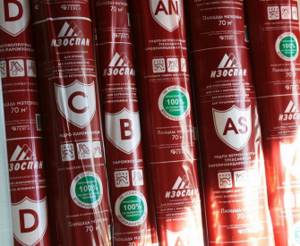
The following materials are suitable for these purposes:
- Two-layer vapor barrier Izospan V is installed before laying the thermal insulation. The material fights condensing moisture well, accumulating it and gradually evaporating.
- Three-layer insulation Alucraft is made on the basis of kraft paper and polyethylene film. It has a reflective foil layer on one side. Alucraft is suitable for protecting ceilings in bathrooms, kitchens and other rooms with high humidity.
- Penofol simultaneously performs the functions of vapor barrier, waterproofing and insulation. The foil coating can be on one or both sides. Self-adhesive material is also available for sale. For installation in a private home, it is recommended to use Type A Penofol, which has a one-sided foil coating. It is easy to use and inexpensive.
How to insulate a brick garage roof
Fiberglass provides low thermal conductivity due to its fibrous structure. The material is made from glass, which is melted and drawn into thin threads. Fiberglass does not burn, does not decompose or rot. However, the material should not be subjected to mechanical stress. During installation, you should work in personal protective equipment so that fiber particles do not get on the mucous membranes and skin.

Mineral wool (basalt) insulation resembles fiberglass in structure, but differs in the source material (basalt rocks). Mineral insulation is a more plastic and elastic material. If installed correctly, the insulation will last for decades. But during installation, the mineral wool should be protected with a vapor barrier from moisture and finishing from mechanical damage.
Expanded polystyrene is very popular due to its ease of installation and low cost. All polymer insulation materials are manufactured using the same technology - the porous structure of polystyrene foam allows them to retain heat for a long time. Technoplex does not absorb moisture and withstands significant mechanical loads, but polystyrene foam is afraid of direct sunlight and is flammable.
A few words about insulation
Choosing a material for insulation is not an easy task. The market today is replete with offers, but choosing a safe, durable, economical and aesthetic insulation is very difficult. Let's look at the top 3 among thermal insulators.
Foam insulation
The most popular and, perhaps, the best option. Among the advantages are:
- lightness;
- versatility (suitable for all types of work - interior, exterior, heat and sound insulation);
- does not absorb moisture, which allows you to do without a vapor barrier;
- strength;
- retains heat;
- resistance to fungus, mold and temperature changes;
- inexpensive;
- convenient for independent work.
Of course, not everything is so rosy. There are also disadvantages:
- flammable;
- exposed to sunlight, which causes it to deteriorate and turn yellow;
- often becomes a haven for rodents.
When using, you should remember the following features of the material:
- installation is carried out using glue;
- Usually they don’t cover it with anything, they just putty and plaster;
- the absence of sheathing will maintain tightness, which, in turn, will save heat.
Insulation with penoizol
A new, young material from the category of liquid insulation. Has the following advantages:
- fire resistant;
- waterproof;
- safe for humans;
- as easy as possible to use - after spraying it turns into a solid layer that completely penetrates all hard-to-reach places;
- does not require protection;
- the need for additional vapor barrier disappears;
- expected to last 50-70 years.
- high price;
- requires special equipment for spraying.
Insulation with glass wool (fiberglass)
A remedy proven by time and the experience of our ancestors. They represent thin glass threads rolled into rolls or pressed into slabs. Advantages:
- in price;
- retains heat well;
- It is resistant to rodents, insects, rot, mold, and mildew.
- voluminous and bulky material;
- sensitive to moisture and mechanical stress;
- difficult to install on your own;
- unsafe: it is strongly recommended to work with it in a uniform, gloves and a mask.
Why insulate a flat roof?
Having dealt with the main issues, let us summarize the need to carry out this rather complex and expensive work. As mentioned above, this design is used mainly for non-residential buildings or similar apartment buildings. In private housing construction there is no need for it. Not only does such a structure weigh more than a classic pitched one, but it also poses difficulties with water drainage. Its only advantage is the low cost of polymer-bitumen roll materials, but this is offset by expensive insulation.
So, why do you need thermal insulation for a flat roof:
- Retaining heat in winter and maintaining a comfortable temperature in summer, this is especially true if there is no technical floor
- Savings on heating and air conditioning, as a consequence of the previous point
- Multi-layer coating virtually eliminates leaks
- Elimination of condensation accumulation and, as a consequence, extension of the service life of the roofing covering
How to insulate a garage roof with your own hands
When insulating the roof internally, we advise you to pay attention to mineral insulation. This insulation does not support combustion, but requires additional protection with a vapor barrier film
The best option for roof insulation is thermal insulation of the garage roof with mineral wool at the construction stage, as in the case of independently insulating an attic with mineral wool from the inside.
How to insulate a pitched garage roof
Technoruf is a modern material that is used as a top layer for thermal insulation of pitched roofs. The material is not flammable, it can be used without loss of characteristics at temperatures from -60 to +400°C. The use of waterproofing when laying Tekhnoruf mineral wool is mandatory. All brands of Tekhnoruf mineral wool are characterized by high density and low thermal conductivity.
https://youtube.com/watch?v=rfVVA284DP4
How to insulate a garage roof from the outside
It is quite difficult to insulate a garage roof from the street so that it lasts for a long time. Therefore, manufacturers offer different solutions to this problem every year. A layer of polystyrene foam or mineral wool insulation for external thermal insulation is located between the roofing and the reinforced concrete slab, but the material should be protected from mechanical damage and moisture.

When insulating a garage roof, you should strictly follow the sequence of laying materials. To begin with, a hydrobarrier, a heat-insulating layer and a vapor barrier are laid. If the ceiling is a reinforced concrete slab, then the thermal insulation materials are attached directly to the roof. Mineral wool is characterized by fire safety and high heat-saving ability and sound absorption.
Expanded polystyrene can be fixed to a flat roof from the outside or inside using dowels. The seams between slabs of foam plastic or extruded polystyrene foam should be foamed. It is advisable to lay expanded polystyrene slabs in two layers in a checkerboard pattern so that the second layer overlaps the seams of the previous layer. Thus, you will reduce the risk of cold bridges in the thermal insulation layer.
How to insulate a garage roof from the inside
When laying thermal insulation internally, you should first treat the wooden floors with an antiseptic and the reinforced concrete slab with mastic. Installation of polystyrene foam on a concrete roof slab is carried out using mounting foam with additional fastening using disc dowels. For single-pitch and gable roofs made of wood, slab insulation is laid between the rafters, and all seams are foamed.

To lay mineral wool, a frame should be built on the ceiling. Many manufacturers produce slabs of increased rigidity that are easily inserted between the rafters. If rolls or slabs of low-density mineral wool are used, then insulation should be laid on the roof lining. After laying the mineral wool, it should be protected with a vapor barrier membrane from moisture penetration.
In the video at the end of the material, you can take a closer look at the entire technology of the work. Let us remind you that when insulating a garage, ventilation of the room should be provided. The fact is that in a warm and humid room the car will begin to rust faster. Don’t forget to also properly insulate the garage door, since most of the heat escapes through this structure in the winter.
Insulation of metal gates
As often happens, owners insulate only the walls and ceiling in the garage, but completely forget about the gate. And they, in turn, are the main source of cold and dampness in the garage. So how to insulate the garage so that the car does not freeze in winter.
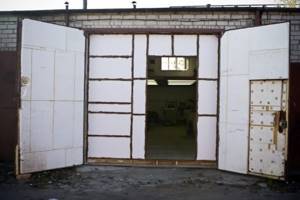
The easiest way is to decorate the inside of the gate with polystyrene foam
- A sheathing is created from the profiles, in the zones of which insulation is laid;
- Fixing foam plastic to the metal base of the gate. You need to use liquid nails.
- The gaps between the foam plastic must be covered with polyurethane foam;
- Spray with polyurethane foam;
Having installed one of the types of insulation, it is worth installing seals on the gate leaves. Even small gaps can make a big difference to the temperature in your garage.
Insulating the garage is guaranteed to increase the life of the car. If all the work is done correctly, you will be able to create the optimal temperature in the garage at any time of the year.
How to insulate a concrete roof of a garage or house
Externally, you can use polystyrene foam and mineral wool slabs of increased rigidity, for example, Tekhnoruf from the well-known company TechnoNIKOL. External insulation of a concrete roof is preferable when the ceiling has been finished inside the room and additional costs will be required for dismantling and installing the finishing. In addition, high-quality waterproofing of the insulation will be required, since it will be exposed to moisture all year round.
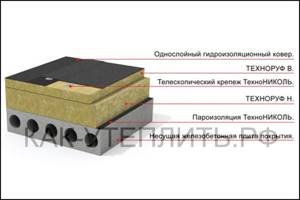
Photo. Scheme for laying mineral wool slabs on a flat roof
If waterproofing is properly installed on the outside, then work can be done from the inside. In this case, you can use cheaper mineral wool with a lower density, as well as foam boards. Please note that carrying out work inside is accompanied by a loss of some ceiling height in the room. And mineral wool needs to be additionally protected with a vapor barrier membrane from moisture contained in the air.
Let's sum it up
If you want to insulate the roof in the garage, you should take into account what stage of construction the structure itself is at.
If the garage is just being built, then it is recommended to insulate the structure from the outside, preserving more free space inside. If the garage is already completely ready, then internal thermal insulation of the roof will be more economical and affordable.
As for choosing a suitable insulation, it should be easy to install, durable, and have maximum fire resistance. Water resistance is a prerequisite for successful insulation of a room, which is not always heated and provokes condensation, in particular this applies to garages.
How to insulate a flat roof
Let's say right away that the choice is limited. It’s not that there isn’t enough choice on the market, but in practice, most often only three alternatives are used. Let’s make a reservation right away: such a roof is not a place for mineral wool. It does not meet the requirements for rigidity, hygroscopicity, or ease of installation: it must be covered with a layer of concrete screed, and this puts additional load on the building, complicates and lengthens the construction cycle.
- Expanded clay or perlite sand. The only advantage of this option is the cost. These are the most affordable materials that have served as a heat insulator for centuries. However, having made such a choice, you will be forced to get out of a number of nuances. Firstly, if the slope is not set by a layer of sand-cement screed on top of the ceiling, it is simply impossible to form the required angle for moisture drainage using loose expanded clay or sand. Secondly, it is unlikely to be possible to achieve the same layer thickness over the entire roof surface. And this will directly affect the thermal conductivity of the finished roof. Thirdly, working with such material and covering it with subsequent layers is simply inconvenient; this prolongs the construction time.
- Foam glass. This type of insulation appeared relatively recently, so there is no need to talk about any established practice yet. It is made from broken glass: the raw material is heated in a furnace to 800–900 degrees, foamed by burning a gas-forming agent (coal), and then slowly cooled. The result is a durable material with a cellular structure. It is produced in the form of blocks, which are cut into small slabs.
Foam glass has proven itself well in the insulation of flat roofs of large areas - industrial premises, multi-storey buildings, and also as an insulator in the construction of swimming pools and buildings with difficult temperature conditions.
- low thermal conductivity coefficient;
- steam resistance;
- absolute incompressibility, which plays a significant role in commercial construction and equipment of exploited roofs;
- service life of at least 100 years;
- absolute resistance to moisture, chemical and biological influences;
- ease of installation - the slabs are laid on ordinary building mixtures.
But there are also significant disadvantages:
3. Extruded polystyrene foam. The undisputed leader in the issue of insulating the flat roof of any structure - from a garage to a giant workshop or a skyscraper with an equipped helipad. Many experts, when describing the technology for installing a flat roof, do not even consider other options. And this is absolutely justified.
EPPS, popularly “extrusion” or “penoplex” (a common noun from the most popular brand PENOPLEX), is the closest relative of construction foam. It is made from the same polystyrene granules, but using a different technology, which results in a rather thin, light, and at the same time durable and dense board with closed cells. Inside the cells there is a gas, which prevents the transfer of heat, as well as the conduction of noise. Of course, all these indicators directly depend on the quality of the material. It is not for nothing that the term PENOPLEX, and not some other brand, has become popular among the people - this is the largest production of EPS in Russia with stable quality.
Advantages of PENOPLEX for flat roofing:
- the lowest coefficient of thermal conductivity allows you to maximally protect the house from heat loss and insulate the roof from excess heat (this is precisely why waterproofing usually wears out: roofing felt is constantly subject to compression from the outside cold and stretching from the heat from the room);
- using slabs it is easy to form an even and stable slope;
- forms a monolithic thermal insulation contour without gaps, and therefore cold bridges (for this, the edge of the slab is given an L-shape);
- high strength and absolute moisture resistance make PENOPLEX an ideal basis for installing a used flat roof, and also allow you to save on vapor barrier;
- resistance to chemical and biological influences, as well as a wide range of operating temperatures allow the roofing pie to serve for at least 50 years;
- installation of PENOPLEX boards occurs quite quickly compared to other types of insulation.
The disadvantages of this material, which appear in other types of work, do not play a noticeable role in this case.
Therefore, we will consider the procedure for installing a flat roof using classical or inversion technology using the example of PENOPLEX.
A few words about insulation
Every owner of a garage and everything in this garage cares, first of all, about the safety of the car, about their health and about the comfort in the room, which for most car enthusiasts becomes a second home.
Therefore, a lot depends on the choice of insulation for the garage , and you need to choose it so that you don’t have to redo the insulation ten times.
Fiberglass (cotton wool) - retains heat perfectly, does not rot (it is not afraid of any fungus), is fire resistant, does not change its characteristics for a long time. But he is afraid of mechanical impact: if fiberglass mats were subjected to impacts during careless transportation, then such material will no longer provide high-quality thermal insulation. When struck, the glass fibers are damaged and the material loses its properties.
Polystyrene foam is a lightweight, porous material that can retain heat well and is not susceptible to microorganisms and fungi. This material does not accumulate moisture at all, so you can do without a vapor barrier without taking too much risk.
Liquid penoizol is the newest and most convenient of all insulation materials. Absolutely harmless to humans, its service life is at least 50 years.
Expert advice on how to insulate a garage roof
A warm garage is one of the main factors determining the good “health” of a car. One cannot but agree with this, because the cause of condensation is sudden temperature changes. And condensation is the number one enemy of metal anti-corrosion protection and, naturally, can cause significant harm to the car. But how to insulate a garage roof, what material will be “warmer”?
The roof is the main component in the system of protecting any structure from adverse weather conditions. Therefore, it is not enough just to insulate it; it needs constant prevention from leakage, dampness, and other things. How to properly insulate a garage roof so that it performs its functions best. There is no need to “discover America”, as for any type of structure there are already specially developed building codes and regulations that indicate the optimal conditions for maintaining machines.
https://youtube.com/watch?v=NrbYylCqtLQ
Insulation materials: why are they needed and what are they?
So, we have already figured out why we need to insulate the garage. Now you need to understand in detail what to insulate it with and what properties are required for insulation. It so happened that the insulation materials needed for a garage roof are not quite similar to those used to cover ordinary houses. This difference occurs due to the fact that many different paints, varnishes and other substances can be found and used in the garage, which can be chemically hazardous and should not be inhaled. If the roof insulation absorbs these vapors and fumes, it can later become a source of serious health problems. That is why the choice of insulation for a garage must be taken seriously. The top sellers are glass wool and polystyrene foam.
Flat roofing is correct and not
Flat roofing in Russia has a worse reputation. According to ordinary people, it must leak, because rain moisture and snow have nowhere to go compared to a pitched rafter roof. Water must certainly accumulate and test the strength of the waterproofing layer every second. And this means constant repairs, waste, effort, nerves...
Where does the stereotype come from? From the very recent past.
In the USSR, flat roofs were used in the construction of multi-story administrative and utility buildings, as well as residential buildings from three to twelve floors. Until now, in advertisements for searching for an apartment they write the sacramental: “Not the last floor,” because it is firmly entrenched in the mind that the roof will leak, the ceiling will get wet and turn black. Proven by practice. In those days, the issue of energy efficiency of buildings was not on the agenda, and therefore no one was particularly concerned about how to get rid of the disadvantages and turn them into advantages. Year after year they patched up roofing felt, whitewashed the ceilings, scolded the material, the hands and those who came up with the idea of building flat roofs, and that was all.
Meanwhile, already in those years it was possible to build truly aesthetic and practical roofs, including in the private sector. Moreover, such a roof has a number of advantages over pitched roofs:
- the final area is significantly smaller, which means the consumption of materials is also reduced;
- there is no need to erect complex rafter structures, and there is no need to ventilate the attic;
- it is easier to work on construction: all manipulations are carried out on a plane, and not at a serious slope;
- more convenient to use: you can walk on it, you can mount solar collectors, antennas, external air conditioning units on it, and also organize an additional recreational area - solarium, barbecue, even a swimming pool;
- there is no risk of snow melting, and there is no need to clear the roof of it: with the correct construction technology, the snow cover will become an additional heat-insulating layer, and in the spring it will melt and neatly flow in rivulets into, again, a properly organized drain;
- gives more options for architectural solutions.
Strictly speaking, a flat roof is not flat at all, it has a slight slope of 2 to 4% to drain water. The slope can be centripetal, then moisture flows from the edges to the center, like in a kitchen sink, and enters the internal drain pipe. Or there may be a reverse slope, when the edge of the roof is 2-4% below the central point, the ridge. Then rain or melt water goes into gutters and drainpipes located on the facade. Therefore, a properly constructed roof should not leak.
The second mandatory condition for a “correct flat roof”, which previously was not taken into account at all, is insulation. After all, from 30 to 40% of heat loss occurs through the roof: warm air collects under the ceiling, and if it does not meet a barrier, it easily leaves your home.
Another side of this coin: it is the warm air from the room that heats the ceiling and melts the snow accumulated outside. Alone, waterproofing can withstand this pressure for some time, and then the layer begins to deteriorate and requires replacement. At the same time, the ceilings are covered with black and white painting of fungus.
Therefore, although the installation of a flat roof is more budgetary, you cannot save on technology. All layers of the roofing pie must be in place and made of materials of proper quality. But what it will be like depends on which design you choose. They are distinguished based on:
- Constructive division into attic and non-attic. From the names it is clear that we are talking about whether you want to equip the under-roof space or not.
- Functional division into exploited and non-exploited. Installing a roof on which people will actively walk, on which they will install furniture, appliances, lay lawns and install swimming pools, is significantly different from installing a roof that will not be inhabited in the future.
- Divided according to the method of insulation into traditional and inversion. That is, the layers are laid in the usual or reverse order.
All classifications are closely related and influence each other. For example, a green roof that is in use, that is, on which a plant carpet will appear, requires inversion laying of the “pie”. And the attic allows you to use both methods.
Whatever problems you solve, constructive or functional, the basis for the execution of any option will be insulation. It serves not only its intended purpose - with its help, the same slope of 2-4% is formed, and also ensures the strength of the top layer. So you need to take the choice as responsibly as possible.
How to insulate a roof from the outside or inside
The choice of thermal insulation method for a garage roof - from the inside or from the street - depends on the roof design and the material used. Each thermal insulation material is unique in its own way, which allows the use of various technologies for roof thermal insulation
You should not choose polymeric and flammable materials; it is better to pay attention to fiberglass or basalt wool
To insulate the garage roof from the inside, you will need preliminary installation of sheathing on the ceiling, laying thermal insulation in the frame, laying a vapor barrier to protect the insulation from moisture, and finishing the ceiling. To insulate the garage roof from the outside, you will need a moisture-resistant material (extruded polystyrene foam or Tekhnoruf). External insulation will protect the concrete roof from freezing.
Safety
When insulating a garage roof with your own hands, you should follow safety rules. Firstly, when working with fiberglass, it is necessary to work with gloves and a respirator so that glass particles do not get on the skin or into the respiratory tract.
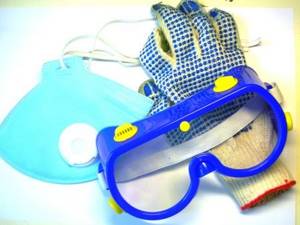
Safety first
Glue and liquid materials - polymers - should be lifted onto the roof only in closed containers. Mineral dust that is formed when working with mineral wool is also harmful: you must wear safety glasses and gloves.
